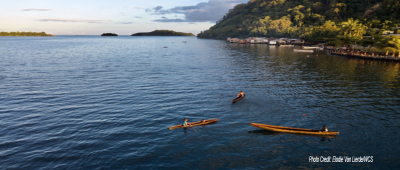In an incredible boon for the planet’s oceans, the government of Papua New Guinea announced more than 1.5 million hectares (more than 16,000 km2) of new Marine Protected Areas (MPAs). The new MPAs more than triple ocean protections in one of the most biodiversity-rich countries in the world, marking a major leap forward for the country and the planet on the road to achieving the global “30x30” target. The project spanned nearly seven years and involved extensive free, prior, and informed-consent processes. The two new MPAs in Lovongai and Murat Local Level Government (LLG) jurisdictions in New Ireland Province were designed and created in a massive partnership between Indigenous Peoples, national government authorities, and local nonprofits including the Wildlife Conservation Society (WCS), Ailan Awareness Inc, and Lolieng Sustainable Programme.
More than 9000 people from upwards of 100 different communities had a voice in the process, on everything from the boundaries of the protected areas to governance rules, making this one of the first and most ambitious community-led MPA wins since governments and the global community committed to 30x30 in 2022. “These declarations are a result of major conservation commitments from the Government of Papua New Guinea at the 5th international Our Ocean conference in Bali in 2018, where we promised to develop 7500 km2 of MPAs in New Ireland Province,” said Kay Kalim, Director of Sustainable Environment Programs at the Conservation and Environment Protection Authority. “With this announcement, we are very grateful to the people of Murat and Lovongai LLG and the people of New Ireland Province and its government for ensuring that we delivered on this commitment.” Papua New Guinea is one of the last places on earth where populations of critically endangered sawfishes can still be found. The two new MPAs include the country’s first-ever rules protecting sawfish and their relatives, the critically endangered rhino rays, making these also the first MPAs in the world with specific measures designed to protect the most threatened groups of sharks and rays. The Murat MPA includes full protection for marine turtles, dugongs, whales, dolphins, and (in five of the six wards) all other shark and ray species rules and details that were agreed upon across dozens of communities, languages, and cultures.
In coming years, Papua New Guinea’s Conservation and Environment Protection Authority (CEPA) believes that there is a huge potential to join or extend these two MPAs to cover an ever-wider area including “the Morgado Square” – area to the northwest of New Ireland where some restrictions are already in place to manage tuna populations. “The work of [establishing the] Murat MPA was not an easy task for all of us, the people of Murat, WCS, and stakeholders,” said Nickson Namalo, the Marine Environment Management Committee Chair for the Murat Marine Protected Area. “Today shows the great achievement of everyone’s efforts, thank you everyone!”
30x30 commits governments to protecting and conserving at least 30 percent of the earth’s land, inland waters, and seas by 2030, a move that will almost quadruple ocean conservation during the next seven years. The community-led approach to designating Papua New Guinea’s new MPAs meant that all local voices had a chance to be heard in the process, and that management is happening where people and species need it most: nearshore. This milestone charts a path toward 30x30 that other countries can study and replicate, a way forward that ensures fishers and Indigenous Peoples lead protection of coastal seas – which is how the most equitable, and most sustainable, ocean conservation progress is achieved.
“In Papua New Guinea, 97 percent of the land and coastal regions are in some form of customary tenure – which means that Indigenous Peoples have rights and a say over their lands and seas,” said Tracey Boslogo, Marine Conservation Officer for WCS Papua New Guinea. “The new Marine Protected Areas in Lovongai and Murat LLGs were established through community input and consensus, both components of the free, prior, and informed consent process. This provides a yardstick for equitable marine management in Papua New Guinea and beyond.” The country will now move to its next project: designing funding streams and climate-smart management structures that will keep the two new MPAs running sustainably, for the benefit of biodiversity and people, for decades.
Source: https://newsroom.wcs.org/News-Releases/articleType/ArticleView/articleId/21438/Papua-New-Guinea-Triples-Ocean-Protection-Announcing-Two-New-Marine-Protected-Areas.aspx; 12 November 2023.

